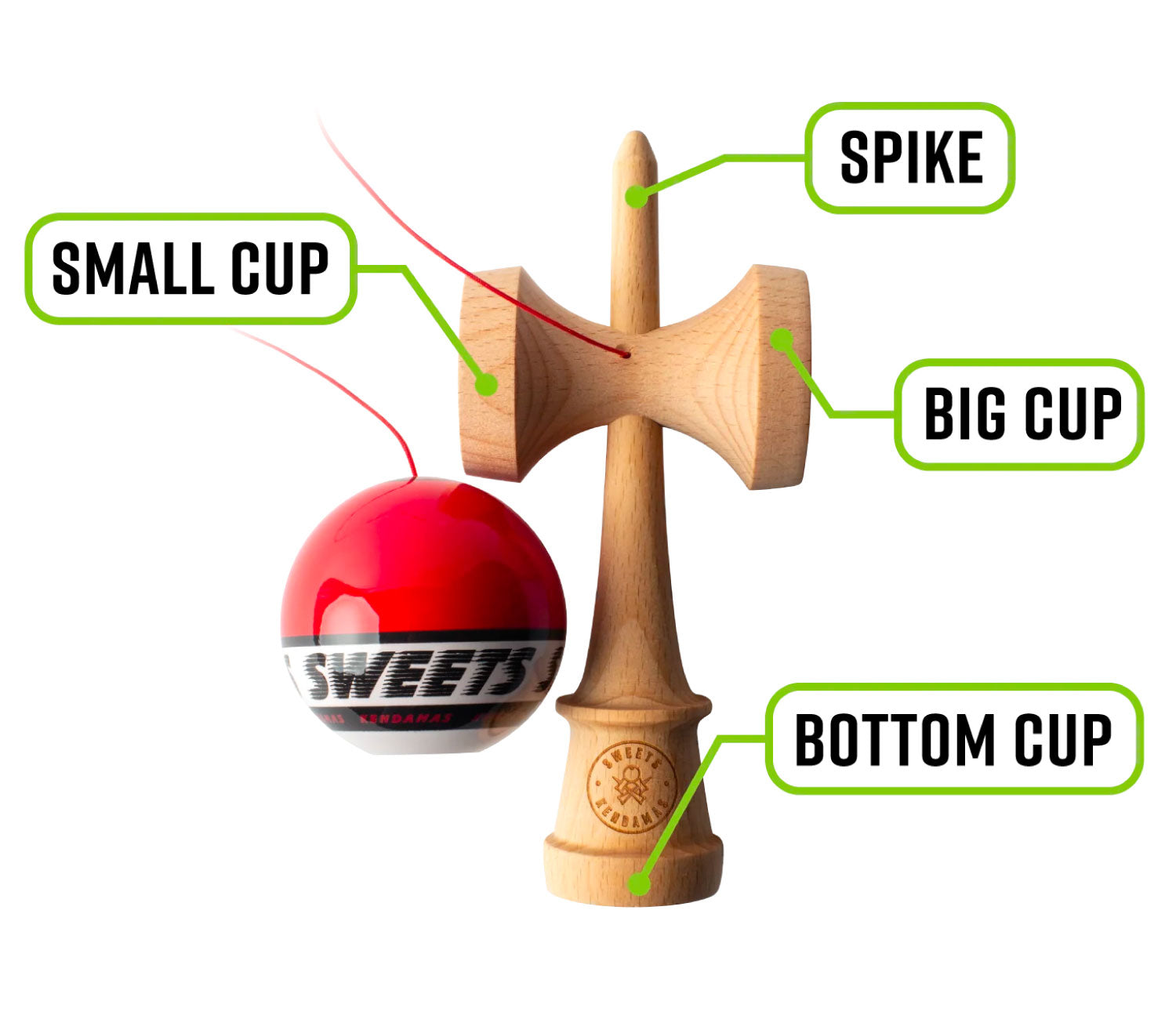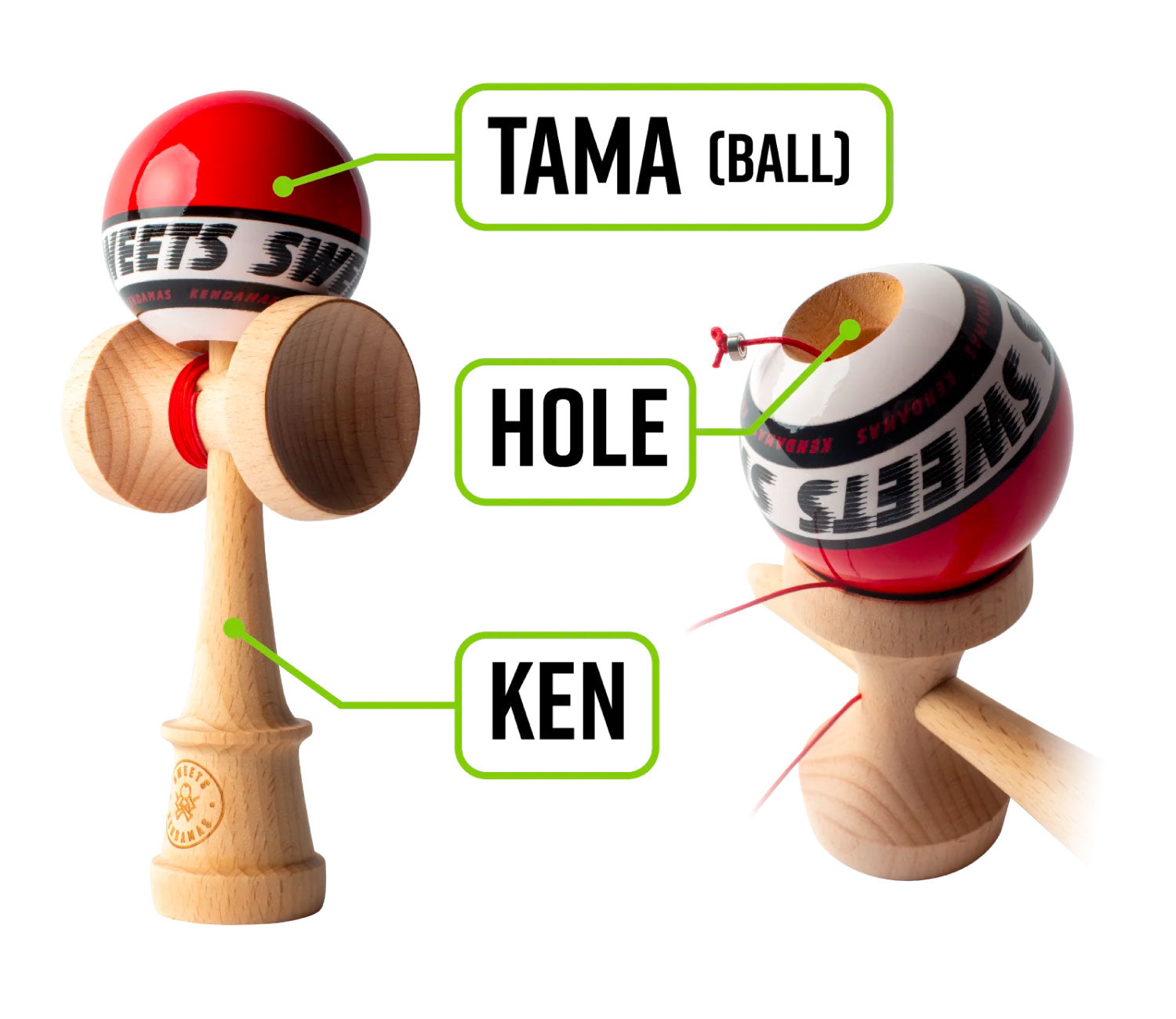What is Kendama?
Kendama is a hand-eye coordination tool & the world’s greatest boredom cure. The game offers endless tricks to learn and a welcoming community of new friends to meet.
To us, Kendama is about never giving up, and learning that practice makes the impossible become not only feasible but attainable. It gives the user a means to increase focus and hand eye coordination, creating self-confidence that can be applied to any other difficult task in life. Much like martial arts or golf, Kendama can never be completely mastered, leaving the possibility open for constant self-improvement.


KENDAMA FAQ:
Kendama can be considered as a toy, a game, and a tool, depending on how it is used and perceived.
Many people purchase Kendamas simply because they find them entertaining and enjoy playing with them in their free time. Traditionally it has been called a skill toy for this reason.
Kendama is a game because there are games to play with it that have rules and objectives. The games require a mixture of strategy and skill. Competitive Kendama players often participate in tournaments and events where they compete against one another to see who can perform the most difficult tricks or achieve the highest scores.
Kendama can be used as a tool to develop skills such as hand-eye coordination, focus, and perseverance. Many people use Kendama as a means of improving their concentration or as a stress-relief tool.
Overall, Kendama can be considered a toy, a game, and a tool. Regardless of how it is categorized, however, it remains a fun and engaging activity that can be enjoyed by people of all ages and skill levels.
Kendama means SwordBall, as (Ken) means Sword and (tama) means Ball in Japanese, but when put together they form the word Kendama.
Hatsukaichi City, Hiroshima, Japan is considered to be the birthplace of the modern day kendama where you can find kendama themed playgrounds and statues. The Kendama World Cup is still hosted annually in Hatsukaichi by GLOKEN, and kendama-do or "the way of kendama" is taught at kendama dojos throughout Japan with teachings and competitions ran by the Japan Kendama Association
The first modern day kendama was made in the early 1900s, which added the crosspiece or sarado to the ken. Kendama entered schools in Japan in the late 1900s, with kids starting to train at the age of 7.
- Kendama Improves hand-eye coordination: Playing Kendama requires a high degree of hand-eye coordination and dexterity. By practicing Kendama, players can improve their hand-eye coordination, reaction time, and fine motor skills.
- Kendama enhances focus and concentration. Kendama requires concentration and focus, which can help improve mental clarity and mindfulness. By practicing Kendama, players can learn to be more present in the moment and develop a greater sense of focus and awareness.
- Kendama encourages physical activity. It is a full body excersize that requires the player to squat up and down while the ball moves to help catch it correctly. By playing Kendama, players can improve their physical fitness and overall health.
- Kendama boosts creativity: Kendama can be played in many different ways, allowing for creativity and self-expression. By exploring different ways to play Kendama, players can develop their creativity and problem-solving skills.
- Provides social opportunities: Kendama has a strong community of players and enthusiasts around the world. By connecting with others through Kendama, players can form new friendships and strengthen existing ones.
- Promotes cultural exchange: Kendama has players all over the globe that are excited to meet each other and share experiences together. Our favorite trips are kendama trips, especially to Japan.
- It's challenging: Kendama requires a lot of skill and precision, and it can take a long time to master. Many people enjoy the challenge of learning new tricks and improving their technique.
- It's fun: Kendama is a fun activity that can be enjoyed alone or with others. Many people find it to be a satisfying and rewarding way to spend their free time.
- It's portable: Kendama is a compact and portable toy, which makes it easy to take with you wherever you go. This makes it a great way to pass the time while traveling or waiting for appointments.
- It's social: Kendama is often played in groups, which can be a great way to make new friends and connect with others who share your interests.
- It's meditative: Kendama requires a lot of focus and concentration, which can be a great way to clear your mind and reduce stress.
- It's a personal challenge: Kendama is a solo activity that allows you to set your own goals and work towards them at your own pace. .
Kendama is for anyone over the age of 7 who likes strategy and skill games. It is great for people who need to fidget with their hands, or find social situations where they aren’t performing a task boring or full of anxiety. Kendama is for people who like games and puzzles, and who enjoy a personal challenge. We have heard that kendama has been therapeutic for things like ADHD and Alzheimers, as well as a stress relief when needing a screen break or brain break. It brings family members together by
We like to say kendama chooses people. One of our favorite parts of kendama is meeting other people who love it like we do.
The differences between kendamas are hard to notice when you first start playing. The main thing to take into consideration is the length of the string. We make them long enough to cut down if you are a beginner.
It takes awhile to get good enough to feel the difference between different shapes and weights, so we encourage you to pick something out that you like the design of and that fits in your budget. All of our kendamas are meant for beginners as much as they are meant for professionals.
Picking out your first kendama is a big step for your personal growth, so don’t make it too hard.
The paint on the ball will get dents, scratches, and chips over time, similar to the bottom of a skateboard deck. This is a sign that you use your kendama, and should be considered marks of experience and pride.
Over time the wood may wear down with heavy use, especially the point of the spike, but this will only result after many hours of enjoying your kendama.
We use kendama to stand out from the crowd. A key to open conversations, opportunities, and friendships through teaching the world about kendama. It is an every day carry, an accessory to your outfit, and a life tool to use as you see fit.
We lay out the steps we recommend starting with on our "How to Play" page. We also have a youtube full of in depth tutorials.
Kendama is like any other sport, its starts with the Grip. Use your knees, and take each try at a catch individually with out rushing.
Re-steady before every attempt, so that the kendama is only under your control, and not affected by prior movement.
Use your knees and lower body to start low, rise up when you pull, then lower down with the ball to cushion the catch.
Landing a move 3 times is usually enough to add it forever into the moves you can do, and then find your flow by adding tricks you have learned together.
Try to always end a series of moves on the spike!
There are many games to play with kendama, and most start with a list of tricks. Some kendama games require the players to be creative make your own list of tricks.
Games we like to play:
Open format / points.
- Choose a list of tricks for your skill level. This can be 2 different lists if players are of different levels of skill.
- Player one gets 1 opportunity to land the first or a random trick from their list. Player 2 then gets 1 opportunity to land the first or a random trick from their list. If one player is successful, and the other player misses, a point is awarded.
- When any player successfully lands their trick, they must move to the next trick on their list.
- The first player to 5 points wins.
Speed ladder
- Players race through a series of tricks. Each trick only needs to be landed once before moving on to the next trick on the list. The player who completes all tricks first wins. (using a timer to keep track of fastest times over multiple rounds is also fun)
Race to Lace
- Spin a ken on the ground to determine who goes first. (the spike pointing to who goes first after the spin)
- Player 1 names the trick that all players will race to land.
- Whoever lands the trick gets a point. First player to 3 points wins
K.E.N
Similar to P.I.G. or H.O.R.S.E, the game begins with the first player attempting a trick. If they land the trick, the next player or all remaining players have 2 tries to land the trick. If you miss, you get a letter.
On the final letter, you have one “Prove it” to use, in which you can make the other player who first landed the trick successfully land it again in order to give you the last letter. Or you can choose to land it yourself, but getting 3 tries instead of 2.
- Freestyle
- This is generally reserved for the highest level of players, in which a timer is set to 30, 45, or 60 seconds, and judges determine who had the best run based on creativity, difficulty, originality, and amount of misses that occur in the constant flow of tricks completed in that time frame.
HISTORY OF KENDAMA
焦らず、慌てず、諦めず (aserazu, awatezu, akiramezu):
“Never rush, Never panic, Never give up.” - Japan Kendama Association Slogan
Most people relate kendama to Cup and Ball or Ball and Cup type toys, and for good reason. In fact, many civilizations throughout history had some form of hand eye coordination training toy or tool that was a ball attached by a string to a handle / cup that was meant to catch the ball on. In Spanish speaking countries, Boilche, Balero, Perinola, Coca, and Emboque. In France, the Bilboquet. It is believed that Kendama is an advancement from the Bilboquet, which likely made its way to Japan via the Nagasaki port prior to 1800.
The Predecessor of the modern day kendama is the “Nichi-getsu Ball” or "Sun and Moon Ball", invented in Hiroshima in 1919.. Kendama is different from its predecessors because of the addition of the sarado, or cross piece. Some tricks still performed to this day are from the early days of Kendama. In the beginning, Kendama was mostly a drinking game for adults in Japan, before work done by the Tokyo Kendama Club and the Japan Kendama Association (JKA)
The JKA was founded in 1975 by Issei Fujiwara, a children's book writer with a unique story. He used kendama to escape the reality of a troubled childhood, the result of his mother passing away and his father disappearing at an early age. After being taken in by a church, he found passion in writing books for children, eventually penning the story that led to the Disney movie “Eight Below.”
Kendama became his life’s passion when he passed a child on the street swinging a kendama around aimlessly. He decided to stop and teach the child how to play, and soon was surrounded by children. Had he not decided to stop and teach kendama, the JKA would never have been formed, and kendama may have never become well known outside of Japan and become the sport it is today.
He was worried that kids were isolating themselves due to strict school examinations, and he wanted to engage them to meet each other, learn life lessons, and share a bond through kendama.
Issei Fujiwara died in 1994, a little more than a decade before there was international passion and motivation to spread kendama for the much of the same reason that he began in the first place.
Kendama began to bloom outside of Japan with the rise of the internet. Kendama USA started to distribute JKA products in 2008, with Sweets Kendamas and Krom Kendama starting in 2010.
With Social Media and grit, these companies started to develop the international community outside of Japan, and it is still growing to this day. We will never forget where we came from, and continue to pay homage to those that spread kendama before us.
We work closely with everyone working to grow the sport and game, including GLOKEN, the Global Kendama Network, the JKA, and other brands that sell kendama.
In traditional business, people who sell what you sell are considered competitors, and even enemies. We view this differently. We should all work together to make our dreams come true, and create a sport and a legacy. This way the future generations can benefit from kendama in the same ways we have.
History above paraphrased from the JAPAN KENDAMA ASSOCIATION WEBSITE.

